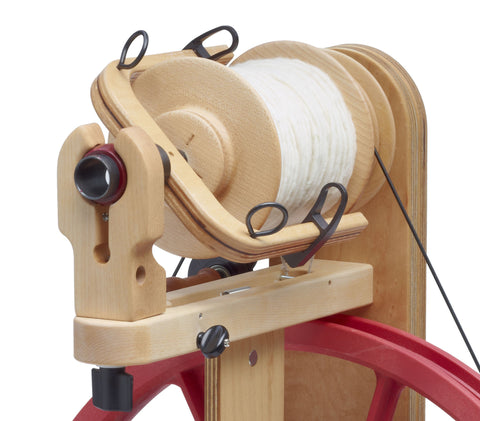Buying Guide - Spinning Wheels
Choosing a spinning wheel can be really daunting for a new spinner looking to buy their first wheel or even the seasoned spinner who's looking for an upgrade.
So, to help you decide which wheel is going to be best for you we've created this buying guide to help you understand the spinning terminology.
Single or Double Treadle? Or Electric?
The treadle is the part that you put your foot on to spin the wheel around. A single treadle wheel means you use one foot to spin the wheel on one treadle. A double treadle wheel has two treadles one for each foot to spin the wheel.
Which one is correct for you comes down to personal preference and the ergonomics of the wheel and you. Single treadle wheels are simple to spin on but some people don't like them if the treadle is positioned on one side of the wheel. Double treadle wheels are usually more ergonomic to spin on as both of your feet are working instead of one foot and making it easier to spin.
You can also get electric spinning wheels which require no treadles and uses a motor to create the spinning motion. These are great if you need to spin large quantities, or if you are not able to use you feet to treadle for periods of time.
However, it really does come down to personal preference and some people adore single treadle wheels and others love double treadle. This is why we have as full a range of wheels available for you to try before you buy so that you can sit down and see which one feels right for you. You are more than welcome to try them at our studio.
Irish Tension, Scotch Tension or Double Drive?
The tensioning system on wheels controls the rate of pull of yarn onto the bobbin as wheel as the spinning action of the wheel. There are 3 types of tensioning system. Some of the wheels we supply can only be configured in one of these tensioning systems but a number of them can be used in two or even all three of the systems as suits your preference and requirements.
Irish Tension
This is the easiest system for beginners as the drive band from the wheel goes over the whorl on the bobbin and spins the bobbin to create the twist in your fibre. It's a very simple set-up and only needs a brake band when the bobbin starts to fill up.
Scotch Tension
Scotch tension gives you a bit more control than Irish as the drive band goes around a whorl that is seperate to the bobbin and flyer and the bobbin take up of yarn is managed by a brake band around the bobbin. This helps to give more control on the twist of the yarn and also makes it pull less than an Irish Tension wheel.
Double Drive
In double drive the drive band is looped around the wheel twice and one part of the band goes over a small whorl on the bobbin and the other goes around the separate whorl on the wheel. This goes the smoothest take up of all systems on the yarn onto the bobbin.
Travel Wheels
If you're going to be travelling a lot with a wheel then it may be worth getting a folding travel wheel to make your life easier.
Due to their compactness travel wheels are great to carry about and you can even get carry bags to make this simpler.
Don't be fooled by their size though as they are vary capable wheels and spin as wheel as their non-folding siblings.
Flyers and Bobbins
There are a range of different flyers (the part of the wheel with two arms that the yarn loops through and 'flies' around before winding onto the bobbin) and bobbins (the part that the yarn winds onto) available that are good for creating different yarns.
Jumbo and Bulky flyers and bobbins are ideal for creating thick and chunky yarns and have a large orifice (hole the twisted fibre goes through on the flyer) to allow such yarns to wind onto bulky bobbins.
High speed flyers, whorls and bobbins are good for creating fine yarns as they are set for winding at a higher speed to put in more twist which is needed for spinning finer yarns.
Standard bobbins and flyers are ideal workhorses for creating most types of yarn and come with all of our wheels.




